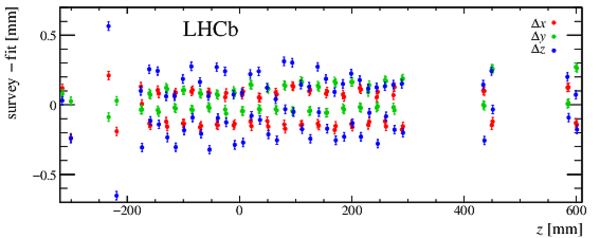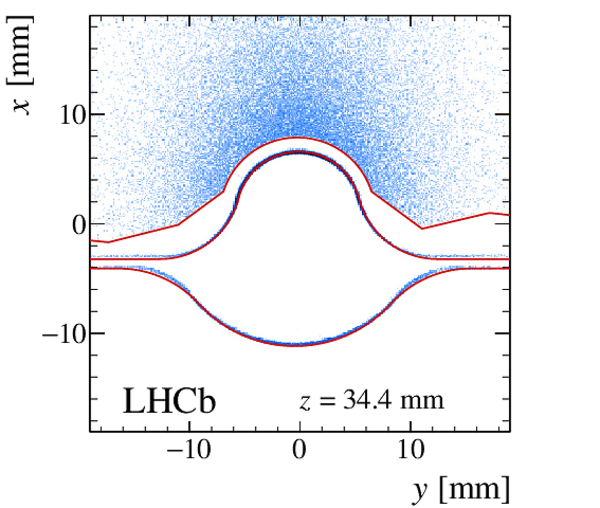Mapping the material in the LHCb vertex locator using secondary hadronic interactions
[to restricted-access page]Information
LHCb-DP-2018-002
arXiv:1803.07466 [PDF]
(Submitted on 20 Mar 2018)
JINST 13, P06008 (2018)
Inspire 1663389
Tools
Abstract
Precise knowledge of the location of the material in the LHCb vertex locator (VELO) is essential to reducing background in searches for long-lived exotic particles, and in identifying jets that originate from beauty and charm quarks. Secondary interactions of hadrons produced in beam-gas collisions are used to map the location of material in the VELO. Using this material map, along with properties of a reconstructed secondary vertex and its constituent tracks, a $p$-value can be assigned to the hypothesis that the secondary vertex originates from a material interaction. A validation of this procedure is presented using photon conversions to dimuons.
Figures and captions
|
From Ref. [1]: (top left) a photograph of one side of the VELO, taken during assembly, showing the silicon sensors and readout hybrids; (top right) a schematic of both an $r$ and $\phi$ sensor, showing the sensor strips and routing lines; and (bottom) schematics showing the cross section of the $xz$ plane at $y=0$, where the $r(\phi)$ sensors are shown with solid blue (dashed red) lines, and an $xy$ view of overlapping sensors in the closed position. { N.b.}, the modules at positive (negative) $x$ are known as the left or A-side (right or C-side). |
VeloAs[..].pdf [248 KiB] HiDef png [6 MiB] Thumbnail [1 MiB] |

|
|
randph[..].pdf [165 KiB] HiDef png [3 MiB] Thumbnail [1 MiB] |

|
|
|
hidef_[..].png [60 KiB] HiDef png [60 KiB] Thumbnail [24 KiB] |

|
|
|
Reconstructed SVs in the Run 2 data sample showing the $xy$ plane integrated over $z$ within the region of the VELO that contains sensor modules. The left (right) panel shows the central (forward) VELO region. The bins are $0.1 mm \times0.1 mm $ in size. |
sv_xyc.pdf [311 KiB] HiDef png [2 MiB] Thumbnail [684 KiB] |

|
|
sv_xyf.pdf [140 KiB] HiDef png [1 MiB] Thumbnail [405 KiB] |

|
|
|
Reconstructed SVs in the Run 1 data sample showing the $zr$ plane integrated over $\phi$, where a positive (negative) $r$ value denotes that the SV is closest to material in the right (left) half of the VELO. The bins are $0.1 mm \times1 mm $ in size. { N.b.}, the inner-most RF-foil region is nearly semi-circular in the $xy$ plane, which results in sharp edges at smaller $r$ values; however, at large $|y|$ values, the RF-foil is flat producing SVs at larger values of $r$ which can easily be mistaken as background in the $zr$ projection shown here. |
sv_zr.pdf [351 KiB] HiDef png [1 MiB] Thumbnail [385 KiB] |

|
|
Differences in the sensor locations relative to the survey specifications. The observed deviations are known from VELO alignment studies and accounted for during reconstruction. |
mod_shifts.pdf [27 KiB] HiDef png [162 KiB] Thumbnail [104 KiB] |

|
|
Comparison between the RF-foil map at $y=0 mm $ and the description in LHCb simulation. |
zx_foil.pdf [97 KiB] HiDef png [342 KiB] Thumbnail [181 KiB] |

|
|
Example comparisons between the (filled bins) reconstructed SV locations and (red lines) the material map for: (top) $x$ versus $z$ near $y=0 mm $; (middle) same as the top but zoomed in on the ${0 < z < 100 mm }$ region; (bottom left) $x$ versus $y$ near the left-half $r$ sensor at $z=34.4 mm $; and (bottom right) $x$ versus $y$ near the right-half $\phi$ sensor at $z=49.3 mm $. For visual clarity: in the top panel, the red vertical lines denote the center of each sensor, while in the bottom panels only the edges of the sensors are shown; and in all panels, only the nominal RF-foil position is shown; { i.e.} the red RF-foil curves do not display its thickness. |
zx_y0.pdf [219 KiB] HiDef png [887 KiB] Thumbnail [274 KiB] |

|
|
zx_y0_zoom.pdf [131 KiB] HiDef png [640 KiB] Thumbnail [201 KiB] |

|
|
|
xy_z34.pdf [205 KiB] HiDef png [2 MiB] Thumbnail [595 KiB] |

|
|
|
xy_z49.pdf [240 KiB] HiDef png [2 MiB] Thumbnail [679 KiB] |

|
|
|
The normalized photon conversion $p$-value distribution obtained using a subsample of data from an LHCb long-lived dark-photon search [8]. The data are consistent with the photon-conversion hypothesis. Some example dark-photon distributions are also shown for lifetimes of 1 and 10 ps, showing good separation between potential exotic signals and photon conversions. |
materi[..].pdf [15 KiB] HiDef png [146 KiB] Thumbnail [142 KiB] |

|
|
Animated gif made out of all figures. |
DP-2018-002.gif Thumbnail |

|
Created on 18 October 2023.
